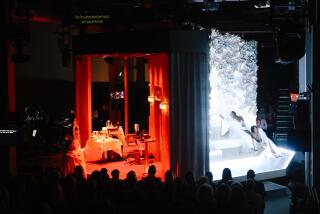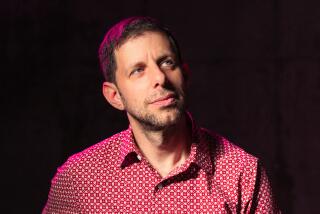‘Far Side of the Moon’ Shines in Brief Run
- Share via
The man in the moon is no idle image for Robert Lepage, the masterfully inventive Canadian theater artist who brought his “The Far Side of the Moon” to the Irvine Barclay Theatre on Friday and Saturday.
Lepage’s piece--virtually a solo--focuses on Philippe, an outwardly drab fellow who’s still working on an advanced academic degree as he enters middle age. He supports his studies--moonlights, you might say--as a newspaper telemarketer. Moonlight is also the subject of his academic study, which centers on the thesis that the Soviet and U.S. race for the moon was rooted in narcissism.
Philippe yearns to examine the far side of the moon--the part that doesn’t reflect the light. In his own life, however, he feels trapped by his circumstances, by a childhood illness that has prevented him from even boarding an airplane, by the shiny reflection of his more successful brother, Andre, who reports the weather on TV.
Lepage plays both brothers, as well as their recently deceased mother, the doctor who treated Philippe’s childhood affliction, and a Soviet cosmonaut with whom Philippe has been corresponding.
As his own director, he also contributes a string of fairly simple but ingenious visual effects. The combination of artfully written and performed monologues and dazzling visual counterpoint, presented in conjunction with a hauntingly plaintive recorded score by Laurie Anderson, succeeds beautifully in varying the texture of the two-hours-plus, intermission-free production.
The fertility of Lepage’s mind is evident from the beginning. During a humdrum visit to a Laundromat, Philippe pokes his head into the washing machine and, courtesy of a camera displaying the view from inside the machine, transforms his cleansing ritual into a visit to outer space; the machine becomes a space capsule.
The set continues to demonstrate this kind of magical versatility throughout the performance. Walls slide in and out, and an overhead bank of reflecting material and lights moves up and down to create a stream of specific places. Likewise, Lepage transforms simple objects--most notably, an ironing board--into a parade of other objects. And he uses a variety of puppets as astronauts and cosmonauts, supplementing a series of film clips that illustrate the space race from the ‘50s and ‘60s.
The visual wizardry climaxes with an elaborate scene in which the prone Lepage, on the floor, maneuvers his reflected image so that he appears to be conducting a space walk. It ends the production on a thematic as well as a visual high note--Philippe may not reach the far side of the moon, but he’ll keep trying.
Still, the predominant tone of the evening is associated with the ironies of Philippe’s life--and, to a lesser extent, Andre’s--instead of the triumphs. Lepage’s one-sided phone conversations, as both brothers, are as spellbinding as his flashier effects; they occasionally suggest some of the early comedy routines of Bob Newhart. And there is one explosively funny moment, as we enter the fantasies of a man trapped in an elevator.
Two nights are not enough local exposure for this remarkable production. Although Lepage has been seen on film recently, his previous theater work here was limited to his 1990 staging of “The Dragon’s Trilogy” at UCLA. That was a longer piece, partially in French, that dealt with more specifically Canadian issues. This one, despite its primary location in Quebec, is entirely in English and should be accessible to just about anyone who has ever given a moment’s thought to the mysteries of the man in the moon.
More to Read
The biggest entertainment stories
Get our big stories about Hollywood, film, television, music, arts, culture and more right in your inbox as soon as they publish.
You may occasionally receive promotional content from the Los Angeles Times.









